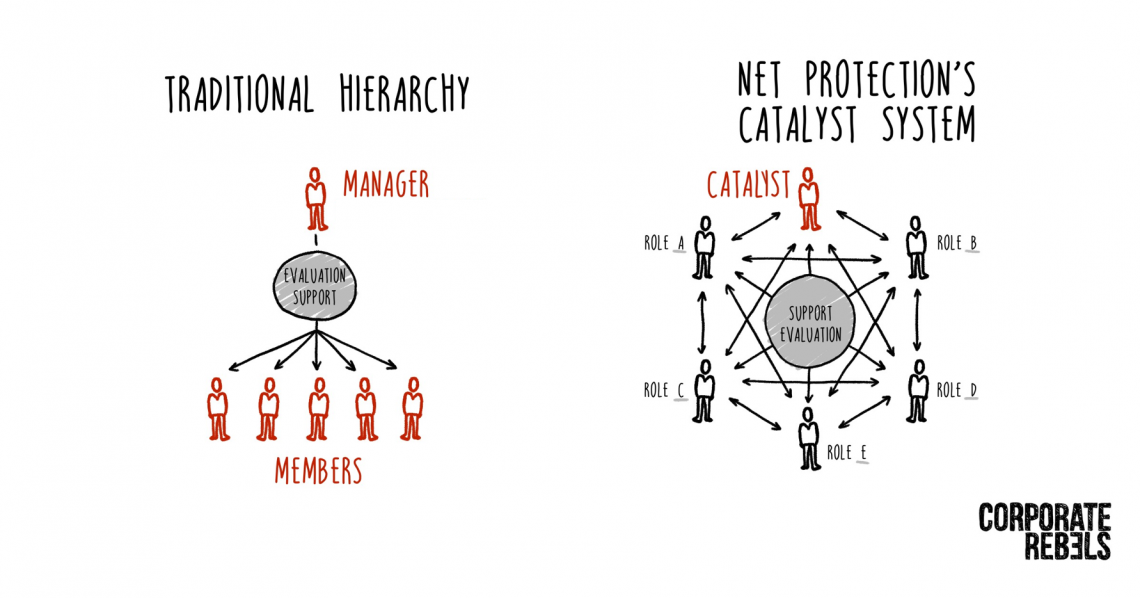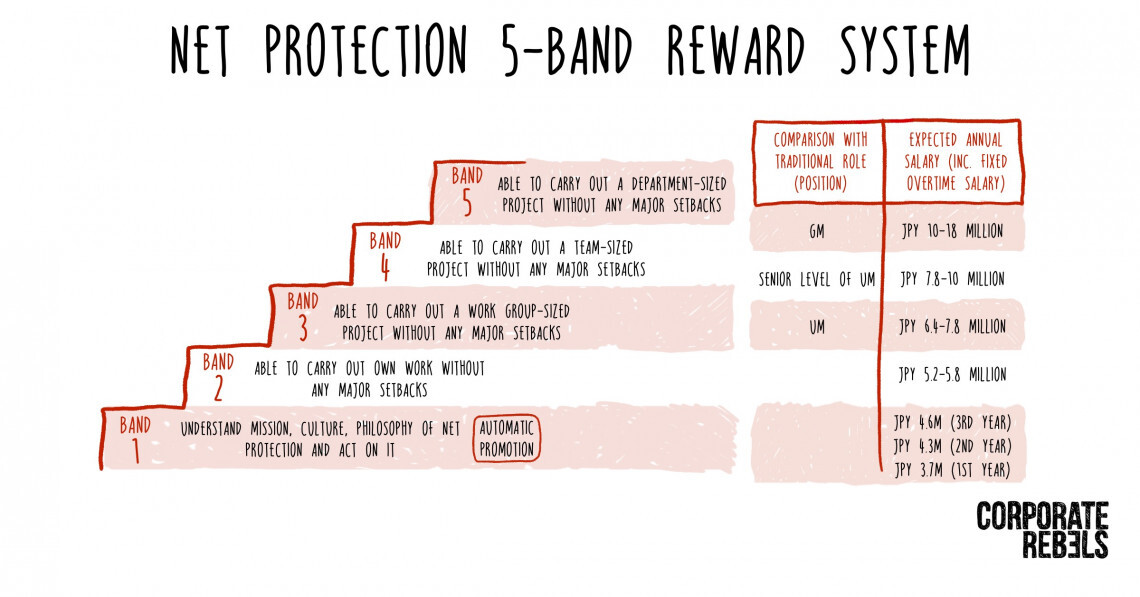Net Protections: A Look at One of Japan's Most Pioneering Organizations

New ways of organizing are appearing all over the globe—including in Japan, which should come as no surprise. So, why don’t we share them with the world?
There is so much great wisdom we would love to bring into Japan and, at the same time, share from Japan. This is one of the primary reasons why I, Yuji Yamada, co-founded our new company, r3s.jp — to contribute more to mutual learning between different cultures.
I would like to share some of the practical stories I find very insightful and would also love to hear feedback and comments that would help foster more mutual learning. For the first story, I will provide an in-depth look at Net Protections, a Japanese company that is relatively well-known for its new and pioneering ways of organizing.
Net Protections
Net Protections is one of Japan's top companies in the Buy Now, Pay Later industry, also known as BNPL. This has been a rapidly growing area in start-ups, as seen by the success of public companies such as Affirm, Klarna, and Afterpay. In fact, one of the major BNPL companies in Japan, Paidy, was acquired by Paypal for close to 3 billion USD in November 2021.
Net Protections was founded in 2000, back when BNPL was barely even an idea. Since then, the company has grown various services in the domain — including both enterprise and commercial — inside and outside of Japan. It became a public company in December 2021, with annual revenue of over 150 million USD, and more than 16 million users. The company currently employs around 300+ members.
Shin Shibata, the current CEO of Net Protections, is not the founder. He was initially an investor from a private equity firm who got so enthusiastic about the business that he stepped in as CEO in 2004. It took another decade for the start-up ecosystem to grow in Japan, so having a CEO from an investment role was rare — and a significant advantage.
Net Protections is very passionate about having a great team and culture. Today, they are seen as one of the more successful companies implementing new ways of working in Japan.
Before going into their progressive management system called Natura, I first want to provide a brief, proper introduction to the company and its history.
History of transformation
Through its 20+ years of growing the business, Net Protections has shifted the company's culture multiple times.
2000-2007:The start-up phase
The company's first years were primarily focused on starting the business. During this period, the BNPL didn’t exist with any real relevance, so the company’s main focus was to expand the market by itself. Sales were up to ¥10B, with 40+ members. The organization was a typical hierarchy, with a handful of middle managers.
2008-2012: The growth phase
Next came the growing phase. The company tripled its sales to ¥36B and doubled its team size to 100+ members. They were still in a hierarchical organization. (In the context of Reinventing Organizations, they were a typical “orange” organization.)
2013-2016: The transforming phase
The turning point came in 2012. The growing phase had created some tough times in the organization, mainly in the emergence of different cultures. Some were passionate about achieving goals; others were more concerned with fostering an inclusive culture.
So, Net Protections responded by taking an important step: the company decided to revise its vision with the involvement of all its full-time members. In July 2012, the company split all its members into teams of six to seven people who spent three months developing their own versions of the company’s new vision. A two-day offsite retreat was held to share all the drafts. The next step was delegated to a project team, including the CEO, to finalize the new vision. Although the company planned on the next step taking three months to come up with the final version, it ended up taking nine months to talk through all the various views within the organization.
Eventually, a new mission emerged titled “Create New Standards,” with seven statements of vision and five values. In the organizational aspect, it was made clear that for Net Protections, the company and the individuals are equal, and the company would give full respect to the members.
And the members? They were expected to give back with their performance.

The true turning point for Net Protections was not only the development of the new statements but also the replacement of some of its members. Over the next two years, more than half of the members who went through the process did not resonate with the new mission and left the company on their own accord. This resulted in shifting the company into a stronger, more unified culture.
2016-2022: The next stage
After this, Net Protections took things a step further. In 2018, they started a new evaluation system called “Natura,” taken from a Latin word meaning “of nature.” This system aimed to enhance the culture of mutual support and collaboration. It removed all the roles of managers and replaced them with so-called “Catalysts.”
The original way of organizing vs. Natura
Based on its new values, the company took this opportunity to completely change the system. The main purpose of the new Natura system was to achieve high performance, individual development, and well-being. It essentially shifted from competition to collaboration, enhancing psychological safety and mutual support in the process.
There were a few interesting changes that came as a result.
Autonomous members
The members at Net Protections work autonomously and are self-managed; this reflects some of the criteria for its recruiting, such as:
- “Think from the origin”
- “Self-motivated”
- “Passionate for self-development”
- “Willing to take responsibilities”
- “Collaborative”
- “Integrity”
Around 2013, when it re-designed its mission and values, the company also shifted the focus of the full-time members mainly to “planning” and “management.” Other roles such as “operations” were shifted to partner companies or part-time employees. This shift corresponded with the new re-designed values; it was meaningful for the member’s self-development and engagement to shift their work to roles that required broader contribution.
It was also reasonable for the business — BNPL companies become profitable not from individual performance but rather from the whole system working smoothly. To achieve this, members need to understand various aspects of the business, such as engineering and customer support. One of the systems to support this involves assigning new graduates to the development team during their first year.

No managers
The organization's basic structure is a matrix — by business and function. In 2018, Net Protections replaced the manager position with “catalysts.” This was precisely in line with its history of organizational transformation.
Catalyst is a fluid role selected in each team (typically around ten members) that is responsible for supporting development within the team. In contrast to the typical manager role, the catalyst is not the person who takes responsibility for the results — the team is. (Although this style of “distributed responsibility” works well, Net Protections is still a public company, so it maintains official roles and department heads for its governance.)
Working Groups
Since 2012, Net Protections has pioneered the ”Working Group” program. Before its restructuring, the opportunities within the company for dynamic delegation from top management were quite limited, creating fewer opportunities. Working Groups were a solution, as the program prescribes members to devote 20% of their working hours to participate in special projects they are interested in aside from their main work.
The Working Groups cover various topics, such as recruiting, training, new business planning, and research for overseas branches. And while the guidelines require 20% of a member’s time, some devote even more, which is fully allowed since all members are self-managing.
The system of the Working Group has taken an essential part in cultivating the autonomous working culture at Net Protections, as members can join voluntarily for whatever they wish to work on.
Virtual Families
One of the systems that has come out from a Working-group is the virtual family, a system called Fami-Tsuku, which has helped to cultivate relationships within the company.
When a new graduate joins the company, a virtual “family” with 5 or 6 members are formed to be a mentor. Basically there are very little instructions for the families (just some rules concerning financial compensation for dinners or coffee). They are there to create good relations between the autonomous members.
Often the family gathers once in a couple of months to go for a drink, and share anything from work issues to personal stories. Since years have passed since they started the virtual families, the new joined member succeeds the warm support to the next family.
Compensation
One of the initial problems that stemmed from Net Protectin’s new system was the amount of unbalance regarding work experience. In 2016, roughly 50% of the members were still within their first three years with the company, while half of the leaders were newly assigned and had less than one year of experience. In short, the organization was very young. That caused frustration in the members who thought the evaluation didn’t seem fair and transparent enough. The system also relied heavily on a very small number of experienced leaders.
This was addressed by changing the main purpose of evaluations from raises in compensation to support of individual development. The basic salary is now determined by 360-degree feedback of competencies, and individual performance is related to bonuses. The monthly 1-on-1, known as Development Support Meetings, is formatted to receive feedback from anyone in the upper tier of job grades.

Additionally, salary bands are now fully disclosed, and within the band, the salary will rise at a fixed rate every half year — and climb up when the band changes.
Overall, compensation is not solely based on individual performance but rather on working as a team and demonstrating competency, leading to success and profitability.
Natura's key success factors
Even though the company had already undergone a major shift in the culture, flattening the structure and changing the way it evaluates was another big change. And it worked.
So, what led this to be successful? One could argue there were three factors.
The first is transparency. Net Protections developed both the system and the culture to keep the company radically transparent. All information in the organization is accessible to anyone by default. This helps foster ownership in the members.
The second is the common experience of the organizational transformation — changing the culture from a hierarchical top-down model to one that is flat and self-organized. This change has taken years, but the overall experience became the underlying support to transform managers into the new role of catalysts.
The third is the development of the leadership team. Throughout the transformation process, the leaders learned to trust team members, be aware of any ego-driven or fear-driven behaviors, and allow the members to manage themselves.
Next steps?
Now that several years have passed since the new Natura system was implemented — along with several other major transformations — what are the next steps, if any?
Now a public company well past its startup phase that began in 2000, Net Protections has started tackling new business opportunities for the next growth phase by hiring and nurturing new talent for future initiatives.
Furthermore, the company’s well-nurtured culture and support systems have succeeded in inviting senior members to the executive team — including the recently joined CFO, who was one of the central figures in the company becoming a public one. As such, Net Protections’ next steps will involve continuing to foster its culture while updating its systems to adapt to any changes needed for continuous business growth in the future.
That's it for now. Thanks for reading. Till next time.


